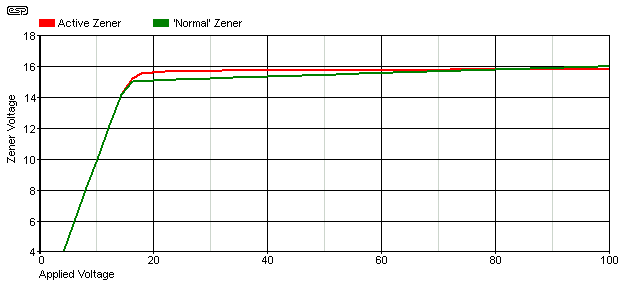

|
| Elliott Sound Products | AN-007 |
 Main Index
Main Index
 App. Notes Index
App. Notes Index
While high power zener diodes are made, they are usually not readily available. They also tend to be rather expensive, and are often stud-mounted types. These are not always easy to install on a heatsink, and the mounting hardware (insulating bush and washer) seems to be all but unobtainable.
Provided you (or your application) can tolerate a slightly higher voltage than may have been specified, a high power zener can be made using an additional transistor and a resistor. Note that this is design guide - it is not a 'final' design, and has to be adapted for your needs. None of the parts shown (or the calculations) can possibly replicate all possibilities, but they will help you to understand the requirements for this kind of circuit.
The method described is not new, and has been used in at least two of the projects described on the ESP website, as well as many commercial products. By using the zener to supply base current to a power transistor, the power rating is limited only by the transistor, with a likely additional limitation imposed by the device current gain at the design current. While zeners generally allow peak (momentary) currents that are much higher than their rated current, the transistor assisted version may not - again, this depends on the transistor.

Figure 1 - High Power Transistor Assisted Zener Diode
The transistor needs to be selected based on the maximum voltage and current expected. If the zener is used only for protection of more sensitive systems on the same power supply bus, the transistor may not even need a heatsink. This depends on the application, so you need to be careful before deciding not to use a heatsink, and/or in the selection of a suitable heatsink based on the power dissipated. R(limit) is the current limiting resistor that's always used with any zener diode. Selection of the value depends on your application and is not covered here.
The circuit shown is simply an example, and Q1 can be any transistor that is suitable for your needs. In most cases, a TIP41 or similar will be more than adequate unless very high voltage or power is needed. For lower powers a BD139 may be acceptable, and you need to select the transistor to suit the voltage and current required for your application. Make sure that you check the safe operating area of the intended transistor!
The maximum allowable current through a zener diode is determined by ...
I = P / V where I = current, P = zener power rating, and V = zener voltage rating.
For example, a 27V 1W zener can carry a maximum continuous current of ...
I = 1 / 27 = 0.037A = 37mA
For optimum zener operation, it is best to keep the current to a maximum of 0.5 of the rated limit, so the 27V zener should not be run at more than about 18mA. Using a lower current is preferable, but always ensure that the zener current is greater than 10% of the maximum, or regulation will suffer. I will generally aim for about 20-50% if practical. The zener current becomes the base current for the power transistor (less the current through R1), and assuming a current gain of 50 and a zener current of (say) 15mA, that means the maximum total 'composite zener' current is ...
15 × 50 = 900mA (Note that R1 current has not been included)
When the current through R1 is considered this will increase the zener current. With 100 ohms for R1, the zener current is increased by about 6.5mA. A 1k resistor will reduce that to 0.65mA (650µA). The voltage is increased slightly (to about 27.7V), and the (maximum recommended) power rating is now ...
P = V × I = 25W
A Darlington transistor can also be used for higher current with low power zener diodes, but will add around 1.5V to the zener voltage. Whether this will cause a problem or not depends on the circuit itself, and is not something that can be predicted in advance. Selection of R1 is somewhat arbitrary, and it will generally be between 100 and 1k ohms. If the transistor has very high gain (or you use a Darlington), R1 needs to be sized so that it forces enough current through the zener diode to get past the 'knee' of its curve - around 10% of the maximum rated current. The zener's total current is the sum of the base current of Q1 and the current through R1. In most cases, the required current will remain fairly constant, but if it varies widely you need to be more diligent with your calculations to ensure performance is maintained over the full range.
The calculations shown here are intended as an example only. This is not a complete design, and you need to determine the requirements for the zener and power transistor to suit your application. The general principles have been covered, but the final circuit has to be designed to ensure that power dissipation of all parts is within their ratings, the zener current is between 10% and 50% of its ratings (considering the operating temperature) and the transistor can dissipate the power needed. R1 is selected to ensure that the zener current is at least 10% of the rated current if the total current is comparatively low. As noted earlier, any resistance between 100 ohms and 1k will generally work, but it's preferable that you either calculate it or make an educated guess. It only becomes (slightly) critical at very low currents, where Q1 passes a small fraction of the total current.

Figure 2 - 'Normal' Vs. Assisted Zener Performance
The above shows the difference between a normal (2.5W) zener vs. a transistor assisted version. The standard zener shows a steady rise of voltage as current increases, but the transistor assisted version maintains a very steady voltage. The voltage varies by only 150mV for a current change from 8mA to 180mA. The maximum current for both is about 180mA, with 15V zener diodes fed via 470 ohm current limiting resistors. In contrast, the voltage across a single zener will change by somewhere between 1V to over 2V for the same current range (this depends on the zener specification).
Construction is not critical, but a heatsink will almost certainly be needed for Q1. Using a clip to attach D1 to the heatsink will allow a higher dissipation, and will allow you to operate the zener at its maximum operating current. Select Q1 to suit the application - in many cases, a raid on the junk box will almost certainly provide something usable. R1 can be 0.25 or 0.5W. Avoid carbon composition resistors which have much higher noise levels than carbon film or metal film types.
Note that the 'composite' or 'assisted' zener has a much lower impedance than a zener by itself, and adding a capacitor in parallel will have very little effect in reducing hum and noise. For example, over a range of 100mA, the voltage may only change by around 100mV, meaning that the 'dynamic impedance' is only 1 ohm. Compare that to a zener by itself that will have a dynamic impedance of many times that value - around 35 ohms for a 1N4750 27V zener. A capacitor can only suppress noise when its impedance is much lower (by a factor of at least 10) than that of the source - at all frequencies of interest. Even a 10,000µF capacitor in parallel is marginal at 100Hz if the composite zener impedance is only 1 ohm. The reactance of the capacitor is 0.16 ohms at 100Hz. If the supply has to be very low noise, using an assisted zener is not appropriate and more complex circuitry is necessary.
 Main Index
Main Index
 App. Notes Index
App. Notes Index